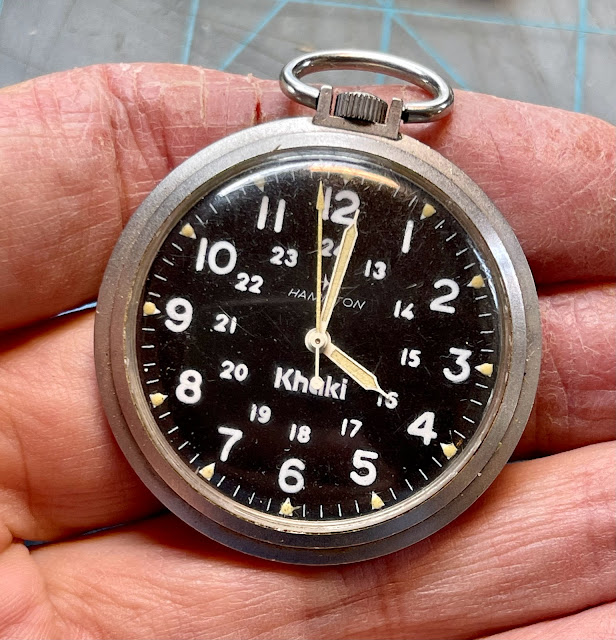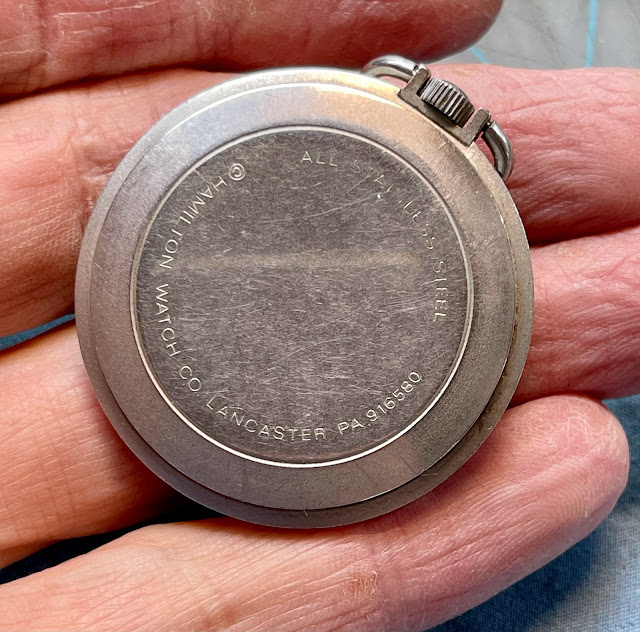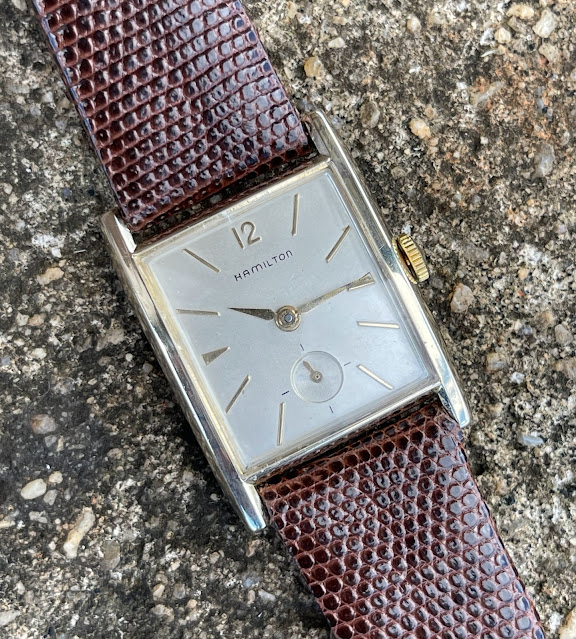I've done a couple of other posts over the past 10+ years on one of Hamilton's most popular models, the 1928 Piping Rock. It was produced through 1935 and then redesigned and reintroduced again in 1948 with the newly introduced 747 movement.
The modern Hamilton company reissued the Piping Rock in the 1990s in both yellow and white electroplate and with both quartz and mechanical movements. So there's a Piping Rock version out there for just about everyone.
However, you really can't beat the original. I recently received an early Piping Rock in need of some TLC and I thought it would be a good project to showcase.
As received, you can see that time and moisture has gotten the best of the dial. The finish on it has been compromised. I'm sure when I reach 94 years old I may have some blemishes too.
The flexible hinges on the three piece case are a bit over-flexed. A talented goldsmith could replace the pin that holds the hinges together and bring them back to their appropriate angle. I've seen worse though and this watch is still wrist-worthy as-is. The plastic crystal is an obvious replacement and replacing that with a glass crystal will be a huge improvement.
The 19 jewel 979 was the top of the line movement in Hamilton's wrist watch lineup. Only solid gold models were outfitted with this caliber at the time. Some gold filled models would receive 979Fs in the early 1930s. The serial number of this movement dates this watch to 1928 - making it a first year example of the model.
With the bezel out of the way and the lighting just right you can see the finish on the sterling silver dial is a bit splotchy. This is an engraved dial so it could be refinished perfectly and look like new if desired. I'll see if I can remove some of the splotchiness since cleaning it won't make it look worse.
If you have a good eye for detail you may have already spotted that the hour hand is the wrong style and size. I'll look in my stash for a better example.
Once the dial and hands are out of the way, it's clear that moisture has gotten inside and corroded the nickel plating of the movement. The damage is done but it shouldn't impact the functionality of the movement (hopefully).
This watch has obviously been seen by a watchmaker at some point over the last 90 years but the mainspring inside is still an old blue steel mainspring. There's a 99.47% chance the spring has set into a tight coil and lost most of its potential energy.
Yup - called it. This watch would run okay for a little while but a full wind would only power it for 12 hours or less, I suspect.
A fresh Hamilton Dynavar white alloy mainspring will power the watch for ~40 hours or so and, most likely, won't need to be replaced again.
Everything is cleaned and dried before being reassembled. Well, I should say "almost everything" - there is one piece missing... the bezel.
The bezel is sitting under the UV lamp getting a suntan while the UV glue that holds the new glass crystal cures. Normally I put crystals in the sunlight to cure but Tropical Storm Ian is currently dumping rain outside my workshop.
I normally can see the Blue Ridge Mountains out my window, but not today. The mountains are hidden by the rain clouds.
The reassembled movement is ticking away with good motion. I always breathe a sigh of relief when a movement from the 1920s starts ticking again. The earliest calibers have the most mileage on them and they didn't always get the regular annual service that Hamilton recommended. This movement is noticeably brighter and shinier now.
After a couple of slight adjustments the watch is running nicely. The beat error of 3.0ms is at the top of my upper spec limit but I don't dare try to adjust it - as doing so could result in goofing up the hairspring and I've learned my lessons the hard way when it comes to these oldest of the old movements. Good is good enough, don't get greedy.
The movement goes back into the case. It's freshly lubricated and rust-free.
A pair of female spring bars came with the watch but only one of them is the correct size. The longer one is too long so I'll have to dig out another 5/8 spring bar from my personal stash.
A new old stock vintage strap completes the restoration. A proper hour hand and a new glass crystal are huge improvements. The dial is better than it was but still not perfect. However, the rest of the watch has good, honest wear so the dial looks totally appropriate to my eye.
Here's another shot in more flattering lighting. I wonder what stories this 94 year old beauty could tell?









































